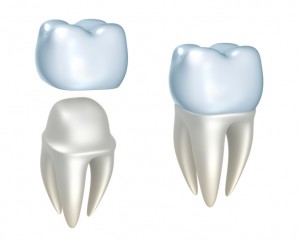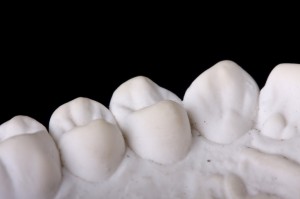 Capped teeth, crowns, caps
Capped teeth, crowns, caps
Call them caps, call them crowns… no matter what you call them, capped teeth can dramatically improve your smile, your bite, and your well-being.
Caps are one of the more popular forms of dental restoration. They’re easy to fit, long-lasting, and covered by most dental insurance plans. If decay, discoloration, or another issue is compromising your smile, it’s time to find an experienced prosthodontist. Capped teeth might be just what you need!
What’s a prosthodontist?
A prosthodontist is a dentist who has specialized in forming and fitting crowns, veneers, bridges, and implants. They’ve gone through three more years of training to practice in their field. There’s really no substitute for that kind of experience. If you want your dental work done right the first time, find a prosthodontist.
When you see your family doctor, it’s not a one-stop shop. You don’t expect them to recommend open heart surgery and then start the operation. You should think of your dentist the same way. They’re great general practitioners, but the procedures for placing crowns, bridges, or implants aren’t simple.
You’d be surprised how large the difference can be between a good prosthodontist and a bad one. You shouldn’t do the research yourself by trying the cheapest option out there.

Dental crowns and tooth
What capped teeth are made of
Dental caps and crowns come in a variety of materials, but the most popular are porcelain, gold, or a compound of the two. The type you and your dentist decide on mostly depends on where the tooth is located in the mouth:
- For front-facing teeth—the ones people see when you smile—a porcelain crown looks most like your other teeth and is often the best choice. Porcelain crowns do cost more than the other options, but they are resilient and look just like a real tooth.
- If the cap is in the back where nobody but your dentist will see it, a gold crown is the more durable and affordable choice.
- You may also opt for hybrid compounds like porcelain fused to metal for your back teeth. They’re a great combination of look and durability.
The steps to get your teeth capped
In an initial screening and checkup, x-rays are taken to determine the extent of the damage to your tooth. If the tooth is in relatively good shape, the cap can be immediately shaped to the tooth’s regular contours and cemented into place.
For severely decayed or broken teeth, you may need to provide a foundation for your crown before with a dental post. Placed deep into your gums, a dental post acts like a new root for the tooth. The bone in your jaw will actually form around the post through a process called osseointegration.
Once you and your dentist agree on the type of crown, you’ll make an appointment for the first of two visits.
Step 1
 In your first visit, the dentist will numb the tooth and surrounding gums. Then they’ll file the tooth down to create room for the cap. After reshaping the tooth, the dentist will make an impression of the tooth using putty. The putty mold goes to a lab where they will create your temporary crown. Now your dentist can stick that temporary crown right on top of that tooth. In all, the procedure takes about an hour.
In your first visit, the dentist will numb the tooth and surrounding gums. Then they’ll file the tooth down to create room for the cap. After reshaping the tooth, the dentist will make an impression of the tooth using putty. The putty mold goes to a lab where they will create your temporary crown. Now your dentist can stick that temporary crown right on top of that tooth. In all, the procedure takes about an hour.
This “temp” will be able to withstand everyday use for the one or two weeks it takes to create and refine your permanent crown. You’ll want to avoid taking chances with it, though, so be especially careful with hard or sticky foods.
Step 2
 When you get the call that your permanent crown is ready, your second visit will be even easier than the first one. After applying a little local anesthetic, the dentist will pop the temporary cap off and cement the permanent one in its place.
When you get the call that your permanent crown is ready, your second visit will be even easier than the first one. After applying a little local anesthetic, the dentist will pop the temporary cap off and cement the permanent one in its place.
You’ll then chew, bite down, and move your teeth around several times. This will allow your prosthodontist to spot any areas that need adjustment or refiling.
Afterwards
Once the anesthesia wears off, it’s not unusual to feel a little soreness or tenderness around the gumline. An over-the-counter pain reliever or an ice pack can help. The pain should diminish quickly, and your bite will quickly feel natural and comfortable.
Caring for your capped teeth isn’t much different than taking care of your regular teeth. Use a soft-bristled toothbrush and floss daily.
With proper care, capped teeth can have a lifespan of 10 or 15 years. If you avoid clenching your teeth, chewing on ice, or using your teeth to rip open packages, they may last even longer.
Are capped teeth for you?
Everyone has different needs and expectations when it comes to their oral health, and we know that budget is near the top of the list for many patients. The Dental Implant Cost Guide suggests that crowns can range from $500 to $3,000. But if your insurance is willing to help out, the most you should expect to pay is about $1,000.
Talk to your prosthodontist and insurance about what you need and what fits your budget. The internet is great for research, but not the same as a conversation. Nothing beats talking through your questions with someone who’s compassionate and knowledgeable.
Don’t rush this decision; don’t settle for the closest or cheapest option. Paying for the right choice and doing your research is worth it. Hopefully your new dental work will last you the rest of your life!
Complimentary consultation
At Dr. Stone’s office in Ft. Lauderdale, we never charge for an initial consultation. We think it’s important to have the best information before making a decision like this. We hope you’ll be happy with your dental work for decades.
Stop by and talk to us. We’ve been here for over 30 years, and Dr. Stone would love to use his expertise to help you find a solution that works for you. Schedule an appointment today!


 Capped teeth, crowns, caps
Capped teeth, crowns, caps
